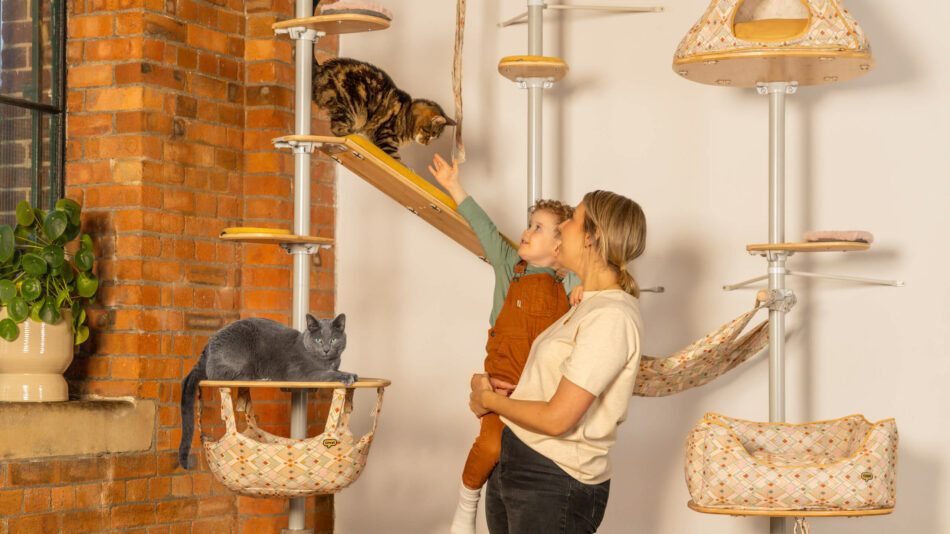7 commonly asked questions about cats
Cats are fascinating creatures, full of quirks that often leave us scratching our heads and wondering what’s going on in those furry little minds. Whether you’re a seasoned cat owner or new to the feline world, it’s natural to have questions about their behaviour. From the mysterious purr to their love of high places, cats exhibit behaviours that spark curiosity. Let’s dive into seven commonly asked questions about cats and explore the unique traits that make them such intriguing companions.
1) Do cats have nine lives?
The myth that cats have nine lives has been around for centuries, and while we know it’s not literally true, there’s no denying that cats have a remarkable ability to escape danger and survive harrowing situations. This legend likely originated from cats’ incredible agility and seemingly uncanny ability to land on their feet from great heights. Their flexible spine and keen sense of balance give them a better chance at survival in risky situations, making it seem like they possess extra lives.
However, it’s important to remember that cats are just as mortal as any other living creature. While they might give the impression of being invincible, they are still vulnerable to injuries and illnesses. Providing proper care, regular vet check-ups, and a safe environment is crucial to ensuring your cat lives a long, healthy life, even if they only have one life to live.
2) Why do cats like lasers?
If you’ve ever watched a cat chase a laser pointer, you’ve likely seen them go wild with excitement. But why are cats so captivated by that elusive red dot? The answer lies in their natural hunting instincts. Cats are predators by nature, and the quick, erratic movement of a laser mimics the behaviour of prey. This triggers their instinct to chase, pounce, and capture the “prey,” even though they can’t physically catch the laser beam.
Looking to elevate your cat’s laser chasing game? Why not give them their love of lasers coupled with their love of scratching with the Switch Cat Scratching Post, designed by Omlet. This ingenious product blends the best of both worlds for cats and creates magic with integrated LEDs in the post that allow you and your cat to explore hours of fun.
3) Why do cats dislike water?
Most cats are known for their aversion to water, and this behaviour often puzzles cat owners. The primary reason cats dislike water is due to their grooming habits. Cats spend a significant amount of time grooming themselves to keep their fur clean and free of oils. When their fur becomes wet, it can feel heavy and uncomfortable, making it harder for them to stay warm and dry quickly.
Another factor could be their evolutionary history. Unlike big cats like tigers, who are excellent swimmers, domestic cats’ ancestors lived in dry, arid environments where water was scarce. As a result, they didn’t develop the same affinity for water as other animals. While there are exceptions, with some cats actually enjoying the occasional bath, most would prefer to stay dry and cozy.
4) Why do cats purr?
The gentle sound of a cat purring is often associated with contentment, but there’s more to this soothing noise than meets the ear. Cats purr for various reasons, and while it’s commonly believed to be a sign of happiness, cats also purr when they are frightened, injured, or even in labour. This suggests that purring could be a way for cats to comfort themselves or communicate with others.
Interestingly, the frequency of a cat’s purr (between 25 and 150 Hertz) has been shown to have healing properties, potentially helping to relieve pain, reduce stress, and promote healing in their bodies. So, the next time your cat curls up and starts to purr, it could be their way of telling you they’re happy, but also that they’re taking care of themselves in ways we’re only just beginning to understand.
5) Why do cats knead with their paws?
Kneading is a behaviour that many cat owners find both adorable and curious. When a cat rhythmically presses its paws into a soft surface, it’s known as kneading, or “making biscuits.” This behaviour is thought to originate from kittenhood when kittens knead their mother’s belly to stimulate milk flow. It’s a comforting action that often continues into adulthood, serving as a sign of contentment and security.
Cats may knead on soft cat blankets, your lap, or even their comfy cat bed. While kneading is generally a sign of happiness, it can also be a way for cats to mark their territory. Cats have scent glands in their paws, so when they knead, they’re leaving their scent behind, claiming their favourite spot as their own. So, if your cat starts kneading on you, take it as a compliment—they’re marking you as part of their territory.
6) Why do cats like to climb?
Cats have a natural instinct to climb, which stems from their ancestors’ need to escape predators and hunt prey. Climbing gives cats a higher vantage point, allowing them to survey their surroundings and feel secure. In the wild, big cats often climb trees to spot prey or avoid threats, and our domestic cats carry this instinct with them.
In your home, this translates to cats seeking out high places like shelves, window sills, or even the top of your refrigerator. Providing vertical spaces, like cat trees or wall-mounted shelves, can help satisfy this natural behaviour and keep your cat happy and mentally stimulated. Plus, it gives them a safe place to retreat to when they need a little alone time.
7) Why do cats like catnip?
Catnip is famous for driving cats into a frenzy of excitement, but not all cats react to it. The response to catnip is hereditary, with about 50-70% of cats being affected by it. The active compound in catnip, nepetalactone, binds to receptors in a cat’s nose, triggering a burst of playful energy. The effects typically last about 10-15 minutes, after which the cat may lose interest until the scent fades, and they can be affected again.
Interestingly, the reaction to catnip is not universal—some cats may roll around, purr, or become hyperactive, while others might simply relax and enjoy a calm state of bliss. It’s worth noting that kittens and senior cats are often less responsive to catnip. If your cat does enjoy it, catnip can be a fun and harmless way to encourage play and enrich their environment.
Omlet and your cat
Cats are full of mystery and charm, with behaviours that never cease to amaze us. Understanding these common questions about your feline friend can help you build a deeper connection and provide a more enriching environment for them. At Omlet, we’re dedicated to celebrating the unique bond between pets and their people, offering products designed to cater to every aspect of your cat’s life. From cosy cat beds to innovative cat trees, our products help answer all of your cat’s questions in a way that you both will love.
This entry was posted in Cats


